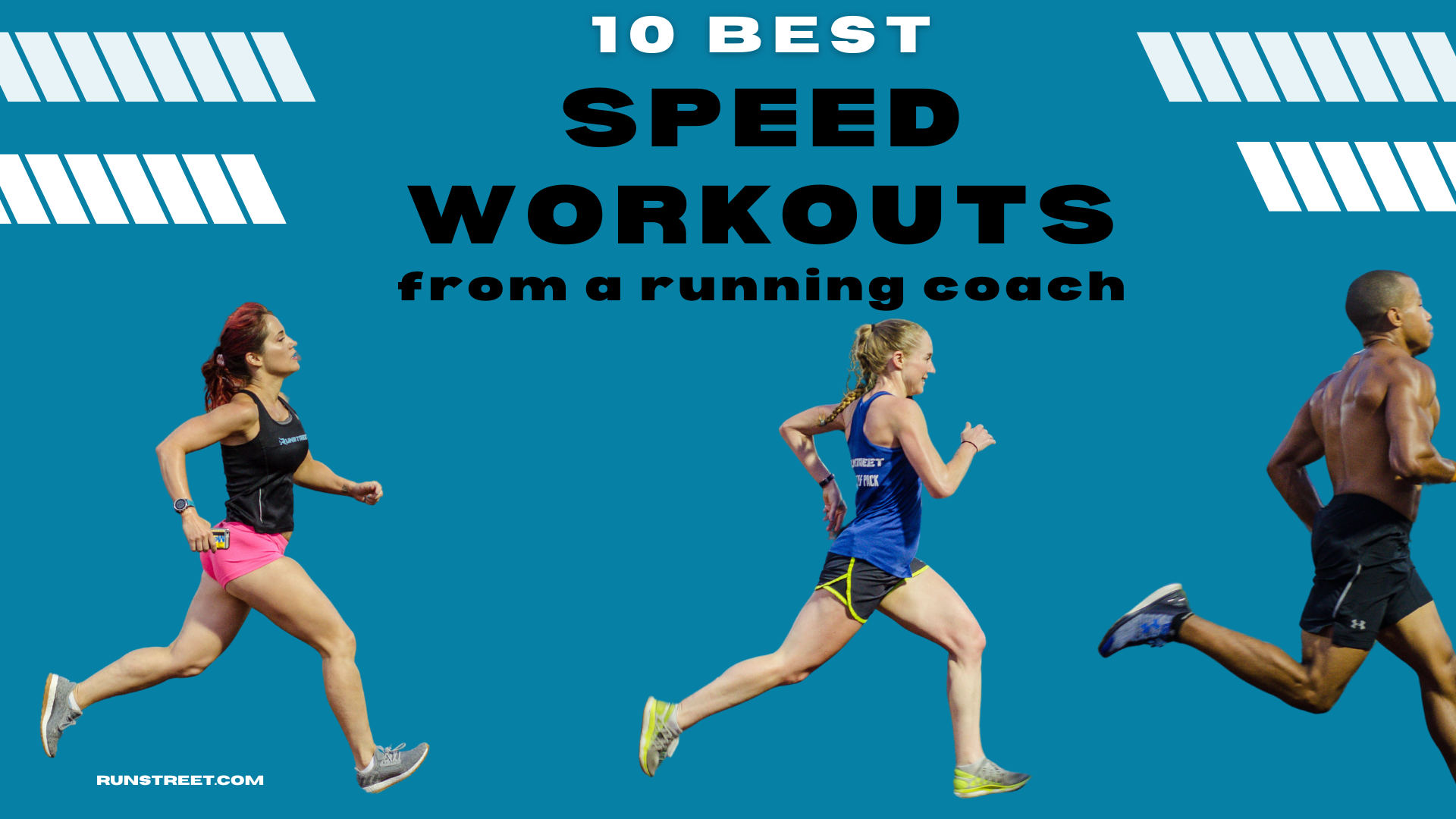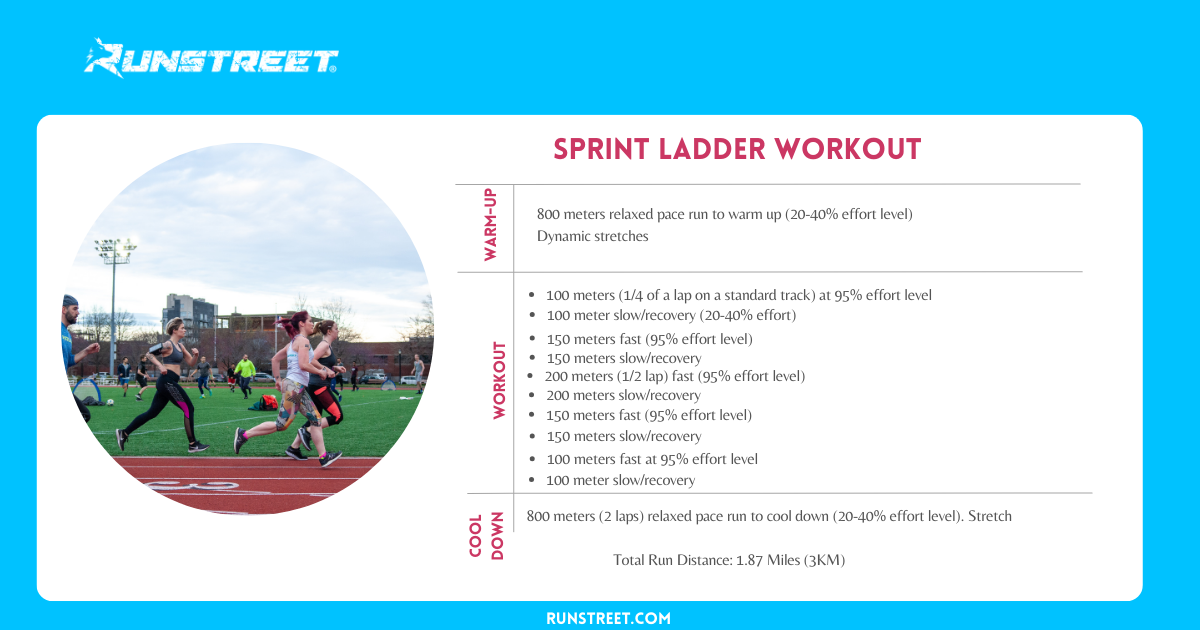Speed Endurance Workouts for Distance Runners and Sprinters
Photos by Marques Jackson Photography.
By Marnie Kunz, NASM-certified trainer, USATF- RRCA-certified run coach
Speed endurance workouts can help you become a faster runner and sustain your running speed for longer. Whether you’re a sprinter training for the 200 or 400 meters, a middle-distance runner training for 800 meters, or a long-distance runner training for a half marathon or marathon, these workouts can help you crush your next race. I'm a running coach who has trained people in distances ranging from sprinting to ultra marathons. I've broken down the speed endurance sessions into long speed endurance and short speed endurance workouts so you can choose what works best for your running goals.
As a running coach and former track runner, I love speed workouts. I have designed these speed endurance workouts for different race distances so you can find the best workouts based on the race you’re training for.
What is Speed Endurance?
Speed endurance is the ability to maintain speed for a sustained period of time. The term speed endurance is general and is most often used for sprinters. However, middle and long-distance runners can also benefit from speed endurance. Improving your speed endurance will boost your Vo2 max (or oxygen efficiency when you run) and running form and efficiency to help you become a better runner.
These speed endurance workouts will prepare your body to run fast for different race distances. If you struggle with losing energy and “dying” before the end of a race, these workouts can help you sustain your fast pace for longer and finish strong.
Benefits of Speed Endurance
There are many advantages to doing speed endurance workouts. Here are some of the most significant benefits of speed workouts:
Faster running speed. The most obvious benefit of speed endurance workouts is improving your running speed. You are training your neurotransmitters and muscles to run faster with speed work.
Increased endurance. These speed endurance workouts will improve your stamina, helping you to run farther.
Better race performances. You will be able to sustain a faster running pace for longer when you do regular speed workouts.
Improved leg strength. Speed training strengthens your leg muscles, glutes, and core muscles. A hard speed workout can give you similar benefits to weightlifting, plus improve your cardiovascular fitness.
Weight loss. According to the National Academy of Sports Medicine, sprint workouts can also help with weight loss because they burn more calories than less intense aerobic workouts.
How Often to Do Speed Workouts
To improve your speed and endurance, do at least one speed workout per week and up to three speed workouts. Two speed sessions a week are ideal for most people to see the best results. It usually takes 4 to 6 weeks to see results from your speed workouts. Be patient and consistent, and you will see significant improvements over time.
Sprinting Endurance Workouts
Sprinting speed endurance allows you to kick up your pace and finish your races strong. These workouts build your aerobic and anaerobic capabilities. The best sprint endurance workouts will help you run faster for the entire duration of your race. Many sprinters struggle with maintaining their pace for the whole race, and these workouts will help prevent excess fatigue and slowing down at the end of a race.
Ladder Sprint Ladder Endurance Workout
This workout is excellent for 200-meter and 400-meter runners. It will improve your speed and endurance while adding variety to your workout program.
This sprint ladder workout will improve your short-distance speed.
Warmup: Run 800 meters (half a mile) at a relaxed, slow pace. Do dynamic stretches.
Sprint 100 meters.
Recover with a slow jog for 100 meters.
Sprint 150 meters.
Recover with a slow jog for 150 meters.
Sprint 200 meters.
Recover with a slow jog for 200 meters.
Sprint 200 meters.
Recover with a slow jog for 200 meters.
Sprint 150 meters.
Recover with a slow jog for 150 meters.
Sprint 100 meters.
Recover with a slow jog for 100 meters.
Cooldown: Run 800 meters (half a mile) at a relaxed, slow pace. Stretch.
For your sprint intervals, run at 90 to 95 percent effort level, almost at your top speeds. Aim for a consistent pace on each interval so each sprint is at the same pace. Your reps should take the same amount of time for each one.
Beginner’s Sprint Workout
If you are new to sprinting or speed work, this workout is a great way to ease into speed training. You should start with 4 or 5 intervals, and over time you can add more intervals to do up to 8 repeats as you build your speed and endurance.
Warm up: Run for 5 minutes at a relaxed, slow pace. Do dynamic stretches.
Sprint for 30 seconds.
Jog for 1 minute at a slow pace to recover.
Repeat 6 to 8 times.
Cool down: Run for 5 minutes at a relaxed, slow pace. Stretch.
For your sprints, aim for a 90 to 95 percent effort level.
Middle Distance Speed Endurance Workouts
This 800-meter intervals workout is great for middle distance runners.
If you’re a track runner specializing in the 800 meters or mile races or a middle-distance road runner training for a mile or 5K race, this middle-distance speed workout will help you get faster and run farther.
800-Meter Speed Workout
Warm up: Run 800 meters (half a mile) at a relaxed, slow pace. Do dynamic stretches.
Run 800 meters fast at 80 to 90 percent effort level. Aim for the race pace you are training for (1 mile or 5K, or if you’re training for an 800-meter race, aim for 30 seconds per mile slower than your 800-meter race pace).
Jog 400 meters at a slow pace to recover.
Repeat 6 to 8 times.
Cool down: Run 800 meters at a relaxed, slow pace. Stretch.
Related Post: How to Do Yasso 800s
Mile repeats are also an excellent workout for middle-distance runners. See our Mile Repeats article or the mile repeats workout below.
Long Distance Speed Endurance Workouts
If you’re a distance runner, these workouts will improve your speed and endurance, help you run faster, and sustain your speed for longer in races. These workouts are geared toward 5K, 10K, half marathon, and marathon runners. The mile repeats can also help mile runners/middle distance.
Mile repeats are especially helpful for middle to long distance runners.
Mile Repeats
Warm up: 800 meters (half of a mile) slow-paced jog. Dynamic stretches.
Run 1 mile at your goal race pace.
Jog 800 meters (half a mile) slow for recovery.
Repeat to do 2-8 repeats.
Cool down: 800 meters to cool down.
Over time you can add more repeats to do up to 8 repeats if you’re training for longer races such as a half marathon or marathon.
Tempo Intervals
Tempo runs improve your oxygen efficiency and speed. This tempo intervals workout can help you get faster for race distances ranging from the 5K to the marathon.
Warm up: 10 minutes running at a slow, relaxed pace. Do dynamic stretches.
Run for 10 minutes at your tempo pace, about 70 percent effort level, or your 10K race pace.
Jog for 3 minutes to recover.
Repeat to do 2 to 4 tempo intervals.
Cool down: 10 minutes of jogging. Stretch.
Related Post: Threshold Run Guide
Tempo Run
Beginners can run at tempo pace for 20 minutes or 2 miles.
This tempo run workout will help you sustain faster speeds for longer. Your tempo run pace should be “comfortably hard,” at a pace that you could maintain for an hour. A good guideline for your tempo pace is to run at your 10K race pace. If you are training for longer races such as a half marathon or marathon, you can do your tempo run for longer - up to an hour - at a slightly slower pace - 30 seconds per mile slower than your 10K race pace.
Warm up: 1 mile running at a slow, relaxed pace. Do dynamic stretches.
Run at your tempo pace for 2 to 6 miles.
Cool down: 1 mile relaxed pace running. Stretch.
If you are training for a 5K race, do a 2- to 3-mile tempo run. For 10K training, run 3 to 4 miles at your tempo pace. For half marathon and marathon training, work up to doing a 5 to 6-mile tempo run.
Training Tips for Speed Workouts
Speed training is considered a hard training day so give yourself at least one full recovery day between speed sessions. This may be a relaxed pace recovery run, cross training, or complete rest. Taking recovery days is important to give your body time to rebuild after higher intensity interval work.
Another way to improve your running speed and efficiency is to do running drills. Check out 10 Running Drills to Become a Better Runner for the best drills.
Nutrition and hydration is especially important for intense workouts like interval training. Bring water with electrolytes or a sports drink with you to your speed workout so you can refuel during and after your run. On the nutrition front, make sure you’re eating enough whole grains for healthy carbs to give you energy for running. Protein-rich foods are also essential to help your muscles recover from intense workouts.
Need more speed workouts? Head to our Training Center to get a customized training program and our 10 Best Speed Workouts.
Related Posts: 10 Running Workouts to Build Speed and Endurance, Tempo Run Guide
Marnie Kunz is a NASM-certified personal trainer and USATF- and RRCA-certified running coach based in Brooklyn, NY. Marnie likes helping people get and stay active to enjoy a better quality of life. When she’s not doing fitness things, Marnie enjoys exploring with her dog, a mischievous rescue Akita.







